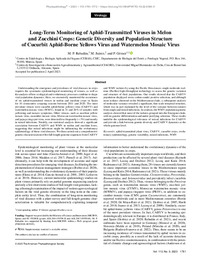Título :
Long-Term Monitoring of Aphid-Transmitted Viruses in Melon and Zucchini Crops: Genetic Diversity and Population Struct of Cucurbit Aphid-Borne Yellows Virus and Watermelos Mosaic Virus |
Autor :
Rabadán Manzanera, María Pilar
Juárez Gómez, Miguel 
Gómez López, Pedro |
Editor :
American Phytopathological Society |
Departamento:
Departamentos de la UMH::Producción Vegetal y Microbiología |
Fecha de publicación:
2023 |
URI :
https://hdl.handle.net/11000/30777 |
Resumen :
Understanding the emergence and prevalence of viral diseases in crops requires the systematic epidemiological monitoring of viruses, as well as the analysis of how ecological and evolutionary processes combine to shape viral population dynamics. Here, we extensively monitored the occurrence of six aphid-transmitted viruses in melon and zucchini crops in Spain for 10 consecutive cropping seasons between 2011 and 2020. The most prevalent viruses were cucurbit aphid-borne yellows virus (CABYV) and watermelon mosaic virus (WMV), found in 31 and 26% of samples with yellowing and mosaic symptoms. Other viruses, such as zucchini yellow mosaic virus, cucumber mosaic virus, Moroccan watermelon mosaic virus, and papaya ring spot virus, were detected less frequently (<3%) and mostly in mixed infections. Notably, our statistical analysis showed a significant association between CABYV and WMV in melon and zucchini hosts, suggesting that mixed infections might be influencing the evolutionary epidemiology of these viral diseases. We then carried out a comprehensive genetic characterization of the full-length genome sequences from CABYV and WMV isolates by using the Pacific Biosciences single-molecule real-time (PacBio) high-throughput technology to assess the genetic variation and structure of their populations. Our results showed that the CABYV population displayed seven codons under positive selection, and although most isolates clustered in the Mediterranean clade, a subsequent analysis of molecular variance revealed a significant, fine-scale temporal structure, which was in part explained by the level of the variance between isolates from single and mixed infections. In contrast, the WMV population genetic analysis showed that most of the isolates grouped into the Emergent clade, with no genetic differentiation and under purifying selection. These results underlie the epidemiological relevance of mixed infections for CABYV and provide a link between genetic diversity and CABYV dynamics at the whole-genome level.
|
Palabras clave/Materias:
Aphid-transmitted plant virus
CABYV
cucurbit crops
evolutionary epidemiology
genetic variability
mixed infections |
Tipo de documento :
info:eu-repo/semantics/article |
Derechos de acceso:
info:eu-repo/semantics/openAccess
Attribution-NonCommercial-NoDerivatives 4.0 Internacional |
DOI :
https://doi.org/10.1094/PHYTO-10-22-0394-V |
Publicado en:
Phytopathology, 113 (2023) |
Aparece en las colecciones:
Artículos - Producción vegetal y microbiología
|

 La licencia se describe como: Atribución-NonComercial-NoDerivada 4.0 Internacional.
La licencia se describe como: Atribución-NonComercial-NoDerivada 4.0 Internacional.
.png)